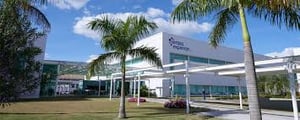EE, the UK’s number one mobile network and part of BT Group Plc (LON:BT.A), announced today that it is switching on 5G sites in 16 UK cities in 2019. The first launch cities will be the UK’s four capital cities – London, Cardiff, Edinburgh and Belfast – and Birmingham and Manchester.
EE is building 5G in the busiest parts of the six launch cites – including Hyde Park in London, Manchester Arena, Belfast City Airport, the Welsh Assembly, Edinburgh Waverly train station and Birmingham’s Bullring – where the power of 5G technology can really make a difference by providing a more reliable data connection to business and consumer customers, even in the biggest crowds.
As well as the six launch cities, through 2019 EE will also be introducing 5G across the busiest parts of ten more UK cities: Glasgow, Newcastle, Liverpool, Leeds, Hull, Sheffield, Nottingham, Leicester, Coventry and Bristol.
EE will launch with multiple smartphone partners, as well as an EE 5G Home router with external antenna, to showcase the power of 5G for broadband.
The BT Technology team is virtualising elements of the core network for 5G rollout in 2019, and is building a next generation 5G core in line with the next stage of global 5G standards, with virtualised network functions on a cloud native infrastructure, creating the basis for a smart and fully converged agile network. The BT 21CN backbone network is Petabit-class, and will ensure the future-proofed scale required to enable a world-leading 5G experience.
Marc Allera, CEO of BT’s Consumer division, said: “Adding 5G to the UK’s number one 4G network will increase reliability, increase speeds, and keep our customers connected where they need it most. This is another milestone for the UK and for our network journey – we’ll keep evolving as we move to one, smart network for our customers. We have an ambition to connect our customers to 4G, 5G or WiFi 100% of the time.”
5G Rollout Strategy
The 5G rollout strategy is determined by the number of business and consumer customers the EE network connects in busy places, and the amount of data those customers use. For example, in the last three months alone, more than 2.1 million individual customers connected around Waterloo station, with just one site at the station carrying more than 100 terabytes of data per day.
The first 1,500 sites that EE is upgrading to 5G in 2019 carry 25% of all data across the whole network, but only cover 15% of the UK population. EE is upgrading to 5G where it can make the biggest difference to the most people. 5G is built on top of EE’s award winning 4G network – customers’ 5G experience will be dictated by the quality of both 4G and 5G, as well as the underlying fixed network.
EE is upgrading transmission to 10Gbps links at each 5G site, and has tested the new links – the fastest in use anywhere in the UK – at its trial sites in Canary Wharf and across East London.
Ongoing 4G Investment
EE is still upgrading 4G sites as part of its overall network strategy, while turning 3G signal into 4G to enable more spectrum for a better network experience. The busiest sites will have five carriers of 4G spectrum supporting the new 5G spectrum, making them the highest speed sites of any UK operator in 2019.
As well as increasing capacity, EE is expanding 4G coverage into rural parts of the UK to give rural communities the coverage and capacity that they need. EE has built more than 350 brand new sites in 2018 alone.
Best Network – Five Years in a Row
In August, EE was named as the UK’s best network for the 5th year in a row. RootMetrics travelled 20,928 miles, and undertook 593,008 tests (including calls, data and text messages), of all four of the UK networks across England, Scotland, Wales and Northern Ireland, in the first six months of 2018. The company has been testing all UK mobile operators every six months since 2012.
EE is currently trialling live 5G in Canary Wharf, and parts of East London. New devices and functionality are being tested in the state-of-the-art Borehamwood test lab.










































